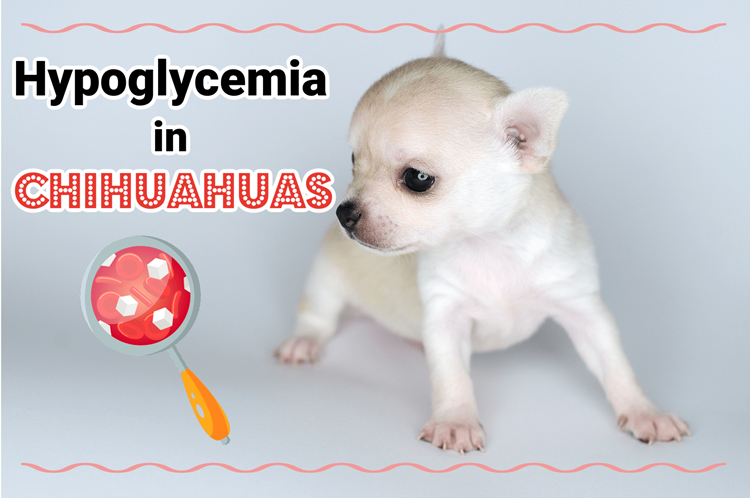
If you own or are planning to own a Chihuahua, you should familiarize yourself with hypoglycemia. All dogs can suffer from it. Hypoglycemia, however, is particularly common in toy breeds. Chihuahuas and other toy breeds may struggle to regulate their blood sugar levels, resulting in a potentially fatal condition known as hypoglycemia.
- What Is Hypoglycemia?
- Hypoglycemia vs Hyperglycemia: What’s the Difference?
- Why Hypoglycemia Is So Common in Chihuahuas
- What Are Normal Blood Sugar Levels for Chihuahuas?
- Causes of Hypoglycemia
- Signs and Symptoms of Hypoglycemia
- Diagnosis for Hypoglycemia
- Treatment for Hypoglycemia
- Will Chihuahua Puppies Grow Out of Hypoglycemia?
- In Conclusion
What Is Hypoglycemia?
Hypoglycemia is a metabolic condition characterized by low blood sugar levels. The term comes from the Greek language, with “hypo” meaning “under,” “glykys” meaning “sweet” and “haima” meaning “blood.” Chihuahuas with hypoglycemia have below-normal levels of glucose in their blood.
Glucose is a simple sugar that comes primarily from carbohydrates. When Chihuahuas eat, their digestive systems will break down the carbohydrates into glucose. The glucose will then enter their bloodstream where it provides them with energy.
Glucose is the primary source of energy for all mammals, including Chihuahuas. The cells in a Chihuahua’s body need it to perform their respective functions. If deprived of glucose, their bodies may shut down.
What Are Normal Blood Sugar Levels for Chihuahuas?
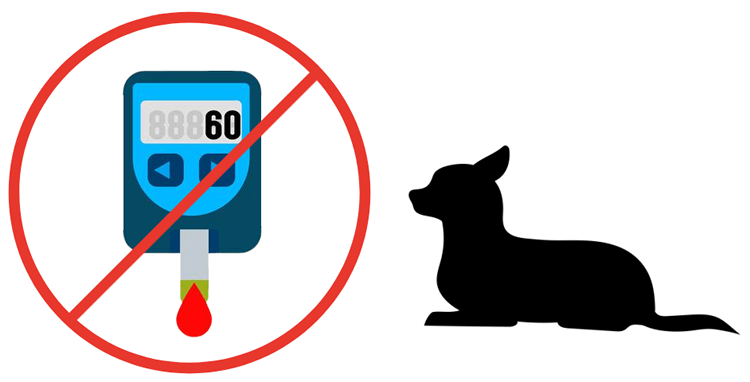
Normal blood glucose levels for Chihuahuas range from about 80 to 120 milligrams per deciliter (mg/dl) or 4.4 to 6.6 millimoles per liter (mmol/L). In the United States mg/dl is the primary metric by which blood sugar levels are measured. Other countries like the United Kingdom and Australia, though, use mmol/L.
Hypoglycemia involves low blood sugar levels. It’s typically defined as blood sugar levels below 60 mg/dl or 3.3 mmol/L. Blood sugar levels can fluctuate. They are often higher immediately after a Chihuahua eats, and they are lower after periods of fasting. Regardless, if a Chihuahua’s blood sugar levels drop below the aforementioned amount, he’s considered hypoglycemic.
Hypoglycemia vs Hyperglycemia: What’s the Difference?
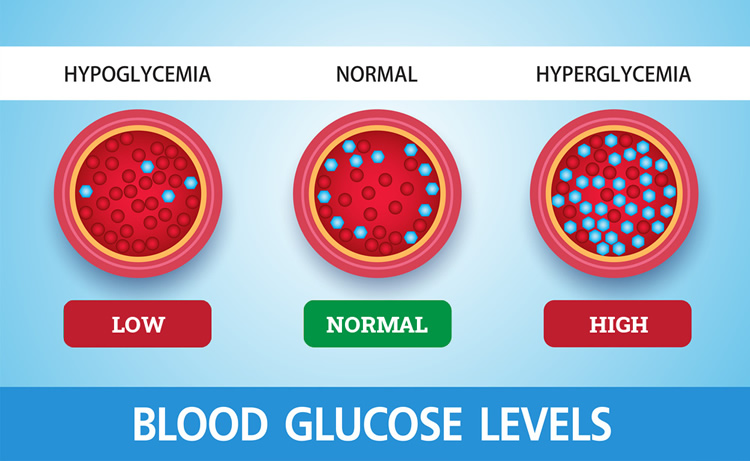
Hypoglycemia and hyperglycemia are two different types of metabolic conditions from which Chihuahuas can suffer. While they both involve blood sugar levels, they are on opposite ends of the spectrum. Hypoglycemia involves low blood sugar levels, whereas hyperglycemia involves high blood sugar levels.
Hyperglycemia is a hallmark symptom of diabetes, which is a disease that affects the production or usage of insulin. Chihuahuas and other mammals produce insulin in their pancreas. Using this hormone, they can lower their blood sugar levels.
Insulin works by transporting glucose from the Chihuahua’s blood to his cells so that it can be used as energy. As levels of insulin increase, the Chihuahua’s blood glucose levels will decrease. Diabetic Chihuahuas, though, may not produce enough insulin, or may not be able to use insulin, resulting in elevated blood sugar levels and, thus, hyperglycemia.
Why Hypoglycemia Is So Common in Chihuahuas
Chihuahuas and other toy breeds are genetically predisposed to hypoglycemia. When compared to larger breeds, toy breeds have higher metabolic rates. They require more energy relative to their body size. This energy comes from glucose in the blood or from stored glucose known as glycogen. Chihuahuas may quickly consume their glucose and glycogen, resulting in hypoglycemia.
In addition to higher metabolic rates, toy breeds have smaller glycogen storage capacities than larger breeds. Glycogen is stored in the liver, fat cells and muscle cells Toy breeds have smaller livers, less fat mass and less muscle mass, so they can’t store as much glycogen as larger breeds.
Another reason hypoglycemia is so common in Chihuahuas is temperature sensitivity. Chihuahuas are more sensitive to cold and hot temperatures than larger breeds. Extreme temperatures can affect their metabolism, resulting in hormonal changes that place them at risk for hypoglycemia.
Causes of Hypoglycemia
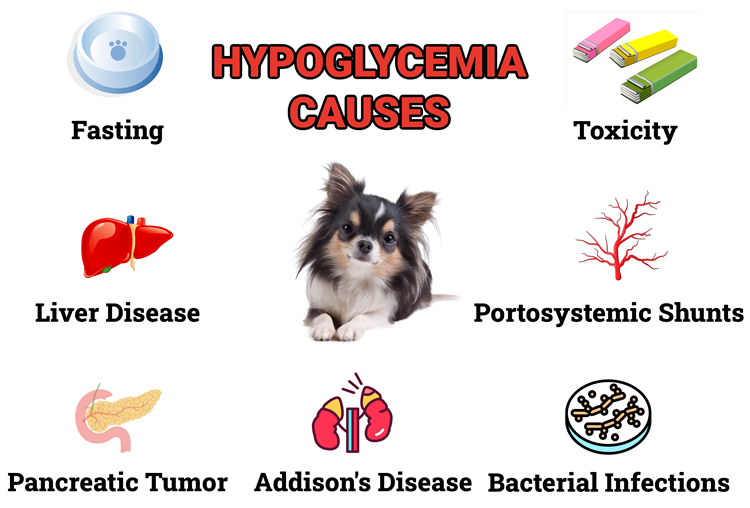
Prolonged periods of fasting can cause hypoglycemia in Chihuahuas. Food contains glucose. If a Chihuahua skips meals, he may not have a sufficient amount of glucose to meet his body’s energy demands.
Liver disease is a common cause of hypoglycemia in Chihuahuas. The liver is responsible for filtering blood. Blood will circulate through the Chihuahua’s liver where toxins are removed.
The liver also stores glucose as glycogen. If the Chihuahua’s blood sugar levels begin to drop, his liver may break down glycogen for immediate energy. Alternatively, the Chihuahua’s liver may convert fat or protein into glucose — a process known as gluconeogenesis. But liver disease may interfere with these processes while placing the Chihuahua at risk for hypoglycemia.
Chihuahuas may experience hypoglycemia if they have a pancreatic tumor. As previously mentioned, insulin is a hormone produced in the pancreas. It’s used to lower blood sugar levels by moving glucose from the bloodstream to the energy-demanding cells. If a Chihuahua has a pancreatic tumor, his pancreas may produce too much insulin. All of this insulin will cause the Chihuahua’s blood sugar levels to plummet.
Addison’s disease can cause hypoglycemia in Chihuahuas. Also known as hypoadrenocorticism is characterized by inadequate production of adrenocortical hormones, such as cortisol. Cortisol is a hormone produced in the adrenal glands. While it’s most commonly known for regulating stress levels, cortisol regulates blood sugar levels as well.
Cortisol raises blood sugar levels by releasing glycogen. With Addison’s disease, Chihuahuas may not produce enough cortisol to release a sufficient amount of glucose to maintain adequate blood sugar levels.
Toxicity can cause hypoglycemia in Chihuahuas. Chihuahuas that consume the artificial sweeter xylitol, for instance, may experience hypoglycemia episodes. Xylitol is toxic to all dogs, but it’s especially harmful to Chihuahuas because of their small size. It only takes about 0.1 grams of xylitol per kilogram of body weight to cause hypoglycemia episodes.
Xylitol is found in the following foods:
- Breath mints
- Chewing gum
- Cough drops
- Dental products
- Diet beverages
- Baking mixes
- Jams and spreads
- Mints
- Nut butters
- Protein bars
- Ice cream
- Coffee or tea mixes
- Puddings and gelatin
- Diet soft drinks
- Yogurt
Portosystemic shunts have been linked to hypoglycemia in Chihuahuas. A portosystemic shunt is an abnormal connection between the portal vein or one of its branches and the main blood supply of the intestines. Normally, blood from the digestive system — intestines, pancreas, etc. — travels through the portal vein to the liver. Photosytemic shunts allow this blood to bypass the liver. Rather than going to the liver, the digestive system blood goes back into systemic circulation.
Bacterial infections can cause hypoglycemia in Chihuahuas. Bacteria feast on glucose. When bacteria enter a Chihuahua’s bloodstream, it will consume his glucose if left unchecked. Bacterial infections may even cause sepsis — a condition in which the Chihuahua’s immune system responds to the bacteria by releasing an excessive amount of inflammatory chemicals in the blood. Sepsis itself can cause hypoglycemia by interfering with glucose-regulating hormones.
Diabetic Chihuahuas may experience hypoglycemia if they overdose on insulin. Insulin injections are used to treat diabetes. Diabetic Chihuahuas may not produce enough insulin on their own, so they’ll experience high blood sugar levels. Insulin injections offer a solution. They serve the same purpose as the insulin produced naturally in the pancreas by lowering the Chihuahua’s blood sugar levels. If a Chihuahua overdoses on insulin, it may lower his blood sugar levels to the point where he experiences hypoglycemia.
Signs and Symptoms of Hypoglycemia
How do you know if your Chihuahua is suffering from hypoglycemia? Hypoglycemia is typically temporary. Most Chihuahuas won’t experience low blood sugar levels forever. Rather, they will periodically experience “hypoglycemia episodes” during which their blood sugar levels drop below normal levels.
Some hypoglycemia episodes are asymptotic, meaning the Chihuahua doesn’t exhibit any observable symptoms while their blood sugar levels are low. Other hypoglycemia episodes are symptomatic, making them easier for owners to detect.
Common signs and symptoms of hypoglycemia episodes in Chihuahuas include:
- Lethargy
- Weakness
- Head tilting to the side
- Confusion
- Loss of balance
- Inability to stand and walk
- Lack of appetite
- Vomiting
- Increased thirst
- Rapid panting
- Bluish-colored gums
- Muscle twisting
- Trembling
- Seizures
Diagnosis for Hypoglycemia
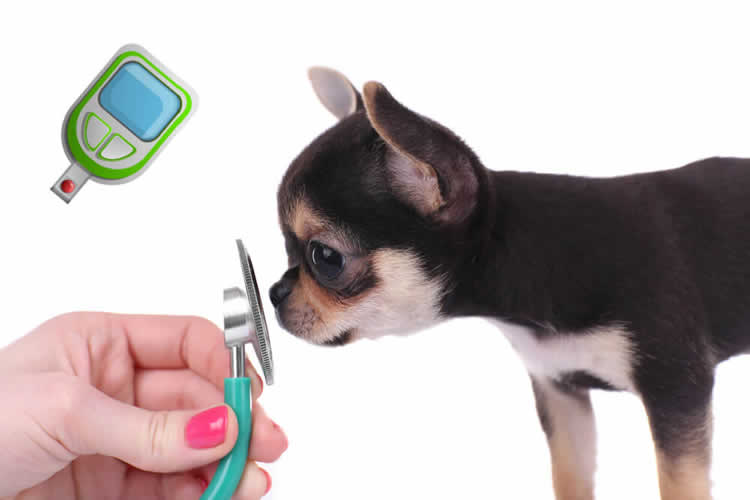
If you believe your Chihuahuas has experienced one or more hypoglycemia episodes, you should schedule an appointment with your veterinarian. Veterinarians can diagnose hypoglycemia by measuring your Chihuahua’s blood sugar levels.
Before measuring your Chihuahua’s blood sugar levels, your veterinarian will likely begin with an examination. Your veterinarian may check your Chihuahua’s weight, gums, eyes and gait. Your veterinarian may also inquire about your Chihuahua’s food and water intake, activity levels and other behaviors.
Your veterinarian may use a glucometer to measure your Chihuahua’s blood sugar levels. Glucometers are devices that measure the concentration of glucose in the blood. Some of them are designed for humans, whereas others are designed for dogs. Regardless, glucometers will analyze a small blood sample for glucose; glucometers for dogs are simply calibrated for dogs, whereas glucometers for humans are calibrated for humans.
Instead of a glucometer, your veterinarian may use a laboratory analysis to measure your Chihuahua’s blood sugar levels. Your veterinarian will collect a sample of blood from your Chihuahua’s vein. Your veterinarian will then ship the blood sample to a laboratory to have it analyzed for glucose.
Measuring blood sugar levels isn’t always enough to determine whether a Chihuahua is hypoglycemic. It will only reveal the Chihuahua’s blood sugar levels at a specific time. You may rush your Chihuahua to the veterinarian at the first sign of a hypoglycemia episode, only for your Chihuahua’s blood sugar levels to normalize by the time you arrive at the clinic. Therefore, your veterinarian may recommend a series of glucose measurement tests. Or your veterinarian may recommend other types of tests, such as an insulin-to-glucose ratio test, hormone test or serum bile acid test.
Treatment for Hypoglycemia
If your Chihuahua is hypoglycemic, talk to your veterinarian about the available treatment options. Treatment for hypoglycemia typically consists of two elements:
- Raising your Chihuahua’s blood sugar levels during hypoglycemia episodes.
- Resolving the underlying cause or causes of the hypoglycemia episodes.
#1) Raising Blood Sugar Levels During Hypoglycemia Episodes
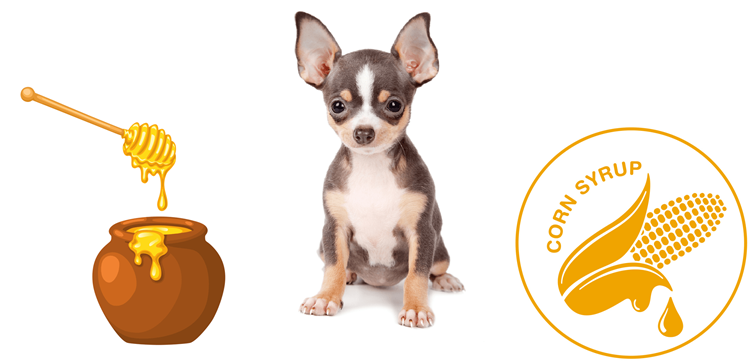
Hypoglycemia episodes can range in severity. Some of them are minor and involve a small drop in blood sugar levels. Other hypoglycemia episodes are more severe and involve a big drop in blood sugar levels. Minor hypoglycemia episodes can often be treated at home with honey or corn syrup.
Rubbing a small amount of honey or corn syrup directly onto your Chihuahua’s gums should raise his blood sugar levels. Your Chihuahua won’t need to swallow it. The sweet substance will quickly absorb into your Chihuahua’s gums. It should stop or shorten the duration of your Chihuahua’s hypoglycemia episode.
For severe hypoglycemia episodes in which your Chihuahua doesn’t respond to the honey or corn syrup, take him to the veterinarian clinic immediately. Severe hypoglycemia episodes can cause seizures, brain damage or death. Veterinarians can treat these severe episodes, however, with an electrolyte solution that contains dextrose. They may hook your Chihuahua up to an intravenous (IV) line that delivers the electrolyte solution containing dextrose. As the dextrose enters your Chihuahua’s body, his blood sugar levels will increase.
#2) Resolving the Underlying Cause or Causes of the Hypoglycemia Episodes
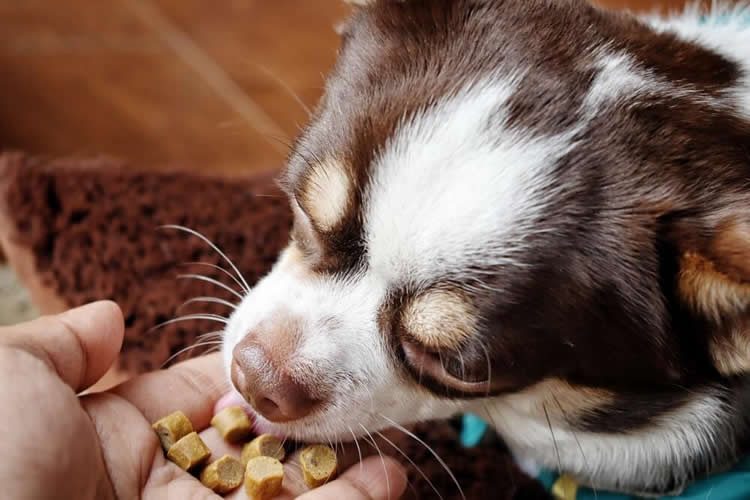
As a more permanent solution, your veterinarian may try to resolve what’s causing your Chihuahua’s hypoglycemia episodes. Hypoglycemia episodes usually stem from one or more underlying causes. Until they’ve been addressed, your Chihuahua will likely continue to experience hypoglycemia episodes.
There are ways to treat or manage most causes of hypoglycemia episodes. If your Chihuahua has Addison’s disease, your veterinarian may recommend cortisol supplementation. If your Chihuahua has a bacterial infection, your veterinarian may recommend a round of antibiotics. For other causes, such as a portosystemic shunt or tumor, your veterinarian may recommend surgery.
Chihuahuas are genetically predisposed to low blood sugar episodes. They have higher metabolic rates relative to their size, limited glycogen storage, and they are susceptible to extreme temperatures. Fortunately, hypoglycemic episodes stemming from genetic factors such as these can still be managed.
Your veterinarian may recommend dietary changes. Hypoglyclic Chihuahuas should eat smaller but more frequent meals. Rather than only feeding your Chihuahua twice a day, feed him four to six meals per day. Each time your Chihuahua eats, his blood sugar levels will increase. Four to six small meals per day will encourage normal, consistent blood sugar levels throughout the day.
Some owners allow their hypoglycemic Chihuahuas to “free feed” by providing them with 24/7 access to food. But the problem with free feeding is that it doesn’t promote consistent eating. After eating a large meal, Chihuahuas may fast. They may not eat again for eight or more hours, during which their blood sugar levels may drop.
You may want to change your Chihuahua’s food if he’s hypoglycemic. Choose a premium kibble that contains a high concentration of protein, fats carbohydrates. Simple carbohydrates are an invaluable source of glucose as well, but they don’t offer the same long-lasting energy as complex carbohydrates. Complex carbohydrates must be broken down in the pancreas before they can be used as energy, so they offer longer-lasting and more sustainable energy. You can ask your veterinarian for a kibble recommendation that’s tailored to your Chihuahua’s specific needs.
Will Chihuahua Puppies Grow Out of Hypoglycemia?
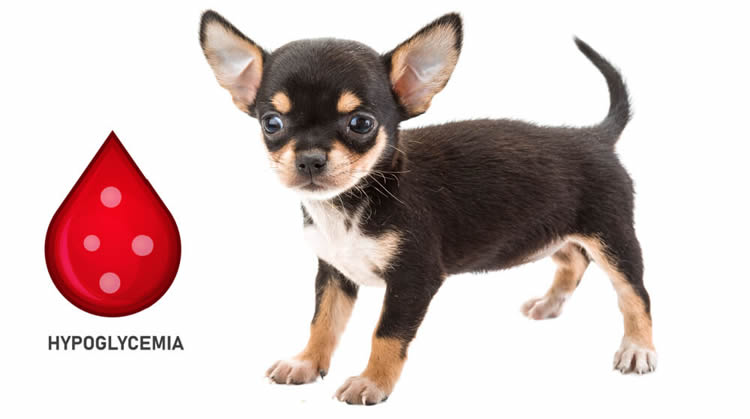
Just because your Chihuahua puppy is currently hypoglycemic, he may not stay hypoglycemic forever. Many puppies grow out of hypoglycemia by 8 months of age.
Puppies, especially Chihuahua puppies, may struggle to regulate their blood sugar levels because of their small size and high energy demand. As they grow older, their bodies will become larger while demanding less energy relative to their size. They’ll develop bigger livers, more muscle mass and more fat mass. Glucose is stored as glycogen in these parts of the body.
In Conclusion
Chihuahuas need glucose for energy. If they have too much glucose in their blood, they’ll experience hyperglycemia. If they don’t have enough glucose in their blood, they’ll experience hypoglycemia.
References:
https://www.ncbi.nlm.nih.gov/pmc/articles/PMC5949948
Do you own a hypoglycemic Chihuahua? Let us know in the comments section below!